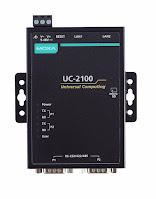 |
| The three phases in building an AI edge computing application—Data Collection, AI Model Training, and AI Inferencing—use different algorithms to perform different tasks |
The Moxa UC-2100 Series Arm-base computing platform is designed for embedded data acquisition and processing applications. It comes with up to two software selectable RS-232/422/485 full-signal serial ports and single or dual Ethernet ports. A variety of models are available for a wide range of interface requirements, such as single or dual serial and Ethernet ports, Gigabit Ethernet, and wireless connections. These versatile communication capabilities allow users to efficiently adapt the UC‑2100 for a variety of complex solutions.
The Cortex-A8 Arm-based processor has been optimized to provide a reliable and secure gateway for data acquisition and processing at field sites and is a useful communication platform for many other large-scale deployments. Models designed for wide temperature applications are available for use in extreme environments such as those found in the oil and gas industry. All models use the Moxa Industrial Linux platform, which provides optimized software features and long-term support.
In many real-world situations, especially highly distributed systems located in remote areas, constantly sending large amounts of raw data to a central server might not be possible. In order to reduce latency and storage costs, while increasing network availability, solution providers and application architects are moving AI and machine learning capabilities to the edge of the network to enable more powerful preprocessing capabilities directly in the field. Indeed, by connecting field devices to edge computers equipped with powerful local processors and AI, there is no longer a need to send all of the data to the cloud for analysis.
Choosing the Right Edge Computer Makes All the Difference
AIoT edge computing essentially enables AI inferencing in the field rather than sending raw data to the cloud for processing and analysis. In order to effectively run AI models and algorithms, industrial AIoT applications require a reliable hardware platform at the edge. When choosing an edge computing solution for AIoT, consider the processing requirements for different phases of the AI implementation and the environment in which the computers are deployed.
Processing Requirements
Since the three phases in building an AI edge computing application — Data Collection, AI Model Training, and AI Inferencing — use different algorithms to perform different tasks, each phase has its own set of processing requirements. Depending on the complexity of the data collected, the computing platforms used in data collection are usually based on Arm® Cortex® or Intel® Atom®/Core™ processors. AI model training requires advanced neural networks and resource-hungry machine learning or deep learning algorithms and hence are typically done using cloud-based services and tools. However, they must be deployed on edge computers that have a conversion tool to convert the trained model to run on specialized edge processors/accelerators, such as Intel® OpenVINO™ or NVIDIA® CUDA®. AI inferencing includes several different edge computing levels, each with its own set of requirements.
Environmental Considerations
Another consideration is the physical location where the application will be implemented. Industrial applications deployed outdoors or in harsh environments — such as smart city, oil and gas, mining, power, or outdoor patrol robots — should have a wide operating temperature range and appropriate heat dissipation mechanisms to ensure reliability in blistering hot or freezing cold weather conditions.
Certain applications also require industry-specific certifications or approvals, such as fanless design, explosion proof construction, and vibration resistance. And since many real-world applications are deployed in space-limited cabinets and subject to size limitations, small form factor edge computers are preferred. Moreover, highly distributed industrial applications in remote sites may also require communications over a reliable cellular or Wi-Fi connection. Another consideration is that redundant wireless connectivity with dual SIM support may also be needed to ensure that data can be transferred if one cellular network signal is weak or goes down.
@MoxaInc @OConnell_PR #Pauto #IIoT




















No comments:
Post a Comment